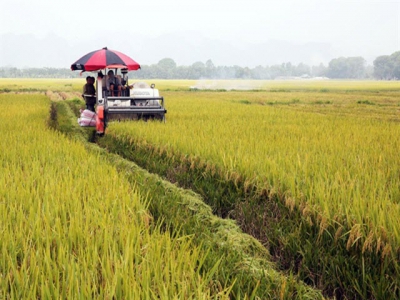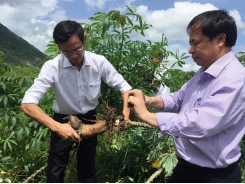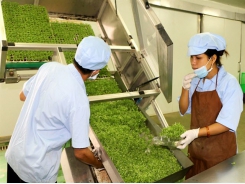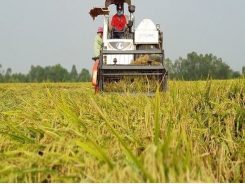Hà Nộis farmers grow high-quality rice for export

HÀ NỘI - Farmers in suburban districts of Hà Nội have switched from growing rice varieties with low productivity to high-quality rice to meet both local and export demand.
Farmers harvest rice in Tam Hưng Commune, Thanh Oai District, Hà Nội. Photo hanoimoi
An 800ha area owned by 16 co-operatives has received investment in the districts of Ứng Hòa, Sóc Sơn, Chương Mỹ, Ba Vì, Phú Xuyên, Mỹ Đức, Thanh Oai and Thường Tín since the start of the spring season this year.
Farmers of Đồng Phú Commune in Chương Mỹ District used to grow traditional, low-yield varieties of rice. Since the farmers switched to organic rice farming techniques in 2012 with the support of the Japan International Co-operation Agency, farmers have reaped more profits.
“Chemical fertiliser–free rice (variety BT7) has a productivity of more than 4,200kg per ha and brings profits which are 2.5 times higher,” said Lê Thị Hồng Lan, secretary of the Party Committee of Đồng Phú Commune.
Đồng Phú Commune is now well known across the northern region for its organic rice brand.
Many other areas in Hà Nội have succeeded in growing high-quality rice varieties and creating recognisable brands such as Bối Khê rice, Bồ Nâu rice, Đông Anh glutinous rice and Sóc Sơn glutinous rice.
Hoàng Thị Hòa, director of Hà Nội’s agricultural development centre, said rice varieties such as Kim Cương 111, Lam Sơn 116, Hương Cốm, Thuần Việt and ĐB18 can yield more than 6,000kg per ha.
Profit from these varieties is estimated to be VNĐ9 million (US$383) more per ha compared to traditional rice varieties.
Aiming to produce rice not only for domestic consumption but also for export, farmers in Mỹ Đức and Ứng Hòa districts are growing Japonica rice in a manner that meets Việt Nam Good Agricultural Practices (VietGAP) standards.
One hectare of land can produce 6,000kg of Japonica rice. This variety is known for its round, thick and hard grains. Thanks to its resistance to pesticides and high quality, it is bought by traders at high prices.
According to Nguyễn Chí Viễn, vice chairman of Ứng Hòa District’s People’s Committee, the district now has more than 2,000ha of land planted with Japonica rice, and local authorities will continue to work to attract businesses to join the production chain.
According to Professor Đỗ Năng Vịnh, president of the scientific council of Agricultural Genetics Institute, Japonica has great potential on domestic and global markets. Each tonne of Japonica is sold for between $800 to 1,500, almost twice the price of Vietnamese varieties.
Director of the city’s Department of Agriculture and Rural Development Chu Phú Mỹ told Hà Nội Mới (New Hà Nội) newspaper that the city aimed to change the planting practices of farmers so their crops are most suitable for export.
It aimed to have 20,000ha planted with Japonica rice (20 per cent of the city’s total rice area) by 2020 and 30,000 ha by 2025. About 50 to 60 Japonica rice planting areas would be formed to produce high-quality rice meeting export standards, he said.
The city's Japonica cultivation project is worth more than VNĐ368 billion during the 2019-20 period. It offers farmers drying, processing and preservation technologies to increase the value of their products.
Có thể bạn quan tâm
Phần mềm

Phối trộn thức ăn chăn nuôi

Pha dung dịch thủy canh

Định mức cho tôm ăn

Phối trộn phân bón NPK

Xác định tỷ lệ tôm sống

Chuyển đổi đơn vị phân bón

Xác định công suất sục khí

Chuyển đổi đơn vị tôm

Tính diện tích nhà kính

Tính thể tích ao hồ



 Vietnam’s agricultural products facing barriers to enter Chinese…
Vietnam’s agricultural products facing barriers to enter Chinese…  Vietnam’s exports to U.S. rise, China-bound shipments dip
Vietnam’s exports to U.S. rise, China-bound shipments dip